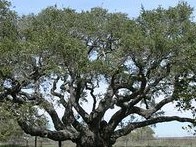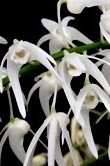Fu si FOR mis: Latin fusus meaning spindle and forma meaning shape
 Fusiformis is usually a specific name used to describe the spindle shape of some part of an organism. Its use is not confined to living plants and is used for a variety of organisms including a fossil (Bensointes fusiformis), a dinoflagellate (Pyrocystis fusiformis ), and a sting horn (Pseudocolus fusiformis ). Fusiformis is also used in the generic name of group of nonmotile, aerobic, parasitic bacteria (Fusobacterium).
Fusiformis is usually a specific name used to describe the spindle shape of some part of an organism. Its use is not confined to living plants and is used for a variety of organisms including a fossil (Bensointes fusiformis), a dinoflagellate (Pyrocystis fusiformis ), and a sting horn (Pseudocolus fusiformis ). Fusiformis is also used in the generic name of group of nonmotile, aerobic, parasitic bacteria (Fusobacterium).
 Of more interest to the gardener is Quercus fusiformis (aka Q. virginiana var. fusiformis) commonly known as Escarpment and Texas live oak. It is a thicket-forming evergreen or semievergreen shrub or spreading tree native to Texas, Oklahoma, and part of Mexico where it grows on dry sites. The trees grow to 20-40 feet high and have gnarled horizontal branches. The acorns are ¾-1 inch long and are spindle shaped, hence the specific name. It is generally considered to be the hardiest of the evergreen oaks and can live in USDA zone 7.
Of more interest to the gardener is Quercus fusiformis (aka Q. virginiana var. fusiformis) commonly known as Escarpment and Texas live oak. It is a thicket-forming evergreen or semievergreen shrub or spreading tree native to Texas, Oklahoma, and part of Mexico where it grows on dry sites. The trees grow to 20-40 feet high and have gnarled horizontal branches. The acorns are ¾-1 inch long and are spindle shaped, hence the specific name. It is generally considered to be the hardiest of the evergreen oaks and can live in USDA zone 7.
 Another plant of interest is oak orchid, Dendrobium fusiforme, also known by a large variety of botanical names including Thelychiton jonesii. It is epiphytic or lithophytic and grows in both the rainforests and open forests of Queensland, Australia. The greenish to white to purple, fragrant flowers are carried in clusters of up to fifty on terminal inflorescences in winter. The plant produces a chain of long, slender pseudobulbs that are spindle shaped, hence the specific name.
Another plant of interest is oak orchid, Dendrobium fusiforme, also known by a large variety of botanical names including Thelychiton jonesii. It is epiphytic or lithophytic and grows in both the rainforests and open forests of Queensland, Australia. The greenish to white to purple, fragrant flowers are carried in clusters of up to fifty on terminal inflorescences in winter. The plant produces a chain of long, slender pseudobulbs that are spindle shaped, hence the specific name.